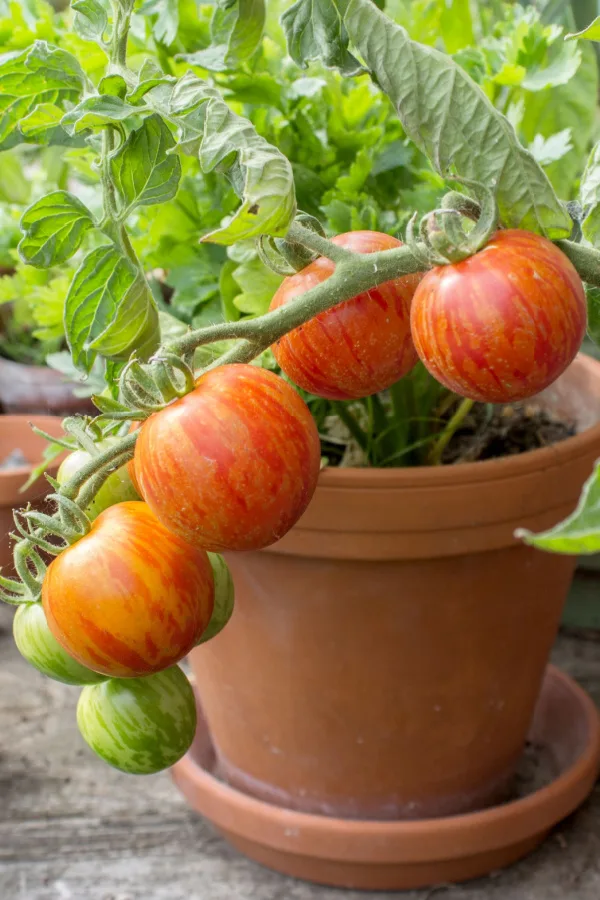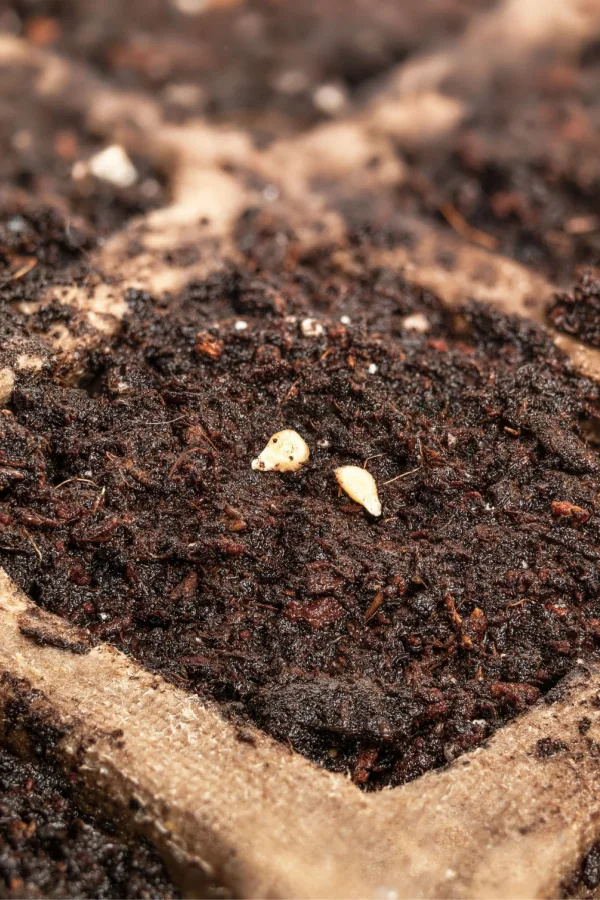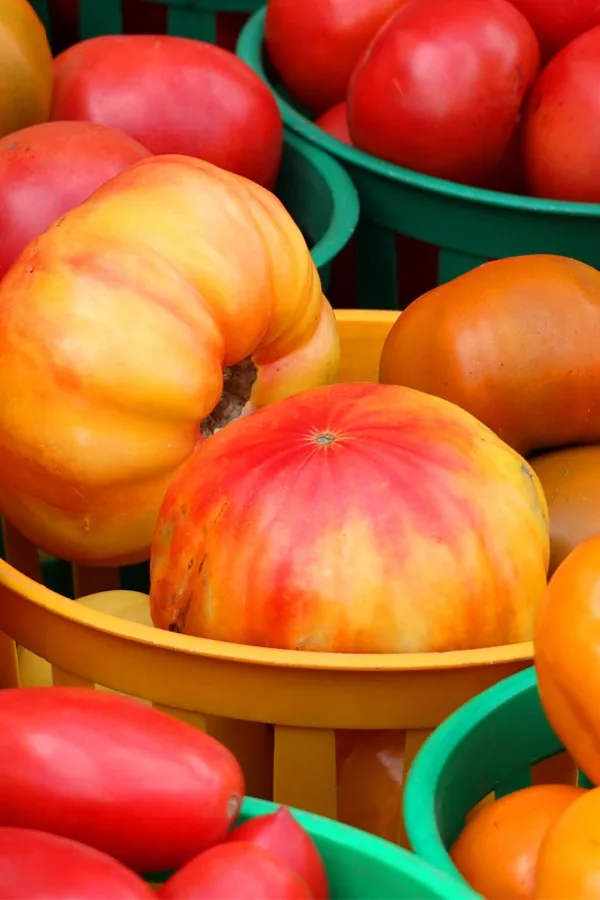If you are looking to plant one of the sweetest, most unique heirloom tomatoes around – then you need to put growing Mr. Stripey tomatoes on your list this year. These beautiful tomato plants produce big, beautiful, bi-colored fruit that will soon become a staple in your growing space!
With fruit that typically weighs at least 14 ounces each, Mr. Stripey tomato rivals other large slicing varieties like Brandywines or Beefsteaks. However, it’s the flavor profile of Mr. Stripey tomatoes that makes it really stand out.
Mr. Stripey tomatoes are known for being low in acid, resulting in a sweet tomato due to its high sugar content. Its juicy, soft flesh is perfect for eating fresh or when combined with other flavors in fresh salads or cooked down in pasta sauces.

While cutting into the Mr. Stripey tomato is a feast for your eyes with its yellow and red flesh, the outside also doesn’t disappoint! The skin features unique and varying red, orange, and yellow stripes.
The plants themselves grow well over four feet tall and feature smaller leaves compared to typical tomato varieties. Since it is an indeterminate tomato, you will be rewarded with these beautiful and sweet tomatoes for a long growing season.
Two Mr. Stripey Tomato Varieties?
Believe it or not, there are actually two different tomato varieties that are both called Mr. Stripey. Depending on your location, your version of Mr. Stripey might be very different than someone else’s.
According to reports, the American Mr. Stripey tomato was discovered in Georgia and introduced to the markets by Wayne Hilton in 1990. Hilton owned several different seed companies but was unaware that there already was a tomato with the same name.
The other tomato variety with the same name was founded in the United Kingdom. The English version of Mr. Stripey tomato is much smaller and is sometimes called Tigerella or Tiger Tom. The tomato in this article is referring to the American heirloom Mr. Stripey tomato.

Growing Mr. Stripey Tomatoes
The American Mr. Stripey tomatoes thrive in the ground but can also be grown in containers. If growing in pots, use a large container with plenty of drainage holes. Keep in mind that you may not have as big of a harvest by growing Mr. Stripey tomatoes in containers due to the restriction of root growth.
No matter where you plant Mr. Stripey tomatoes, you want to include some sort of trellis system or support. Since it is an indeterminate variety, these tomato plants can grow exceptionally tall and get unruly if left unsupported.
As with most tomato varieties, Mr. Stripey requires a location with well-draining soil that receives full sun. Without full sun, your tomato plant will grow but will likely will struggle to produce much fruit.
Starting Seeds Indoors
Since Mr. Stripey tomato is a newer variety, you likely won’t see transplants in most local nurseries or garden centers. You will have much better luck purchasing the seeds and starting them indoors. (Affiliate Product Link: Mr. Stripey Tomato Seeds)
The good news is that since Mr. Stripey tomatoes are heirloom plants. That means you will be able to save the seeds from their fruit to grow again the following year. With a little investment in the seeds now, you can be set forever! (See, “How To Save Heirloom Tomato Seeds”)

The seeds of Mr. Stripey tomatoes take around 80 days from planting until they produce tomatoes. For this reason, you need to start the seeds indoors 8 to 10 weeks before you plan on transplanting them into the garden.
Be sure to harden off the transplants prior to moving them completely outside to avoid shock. Going directly from indoors to the garden can cause the plants to suffer.
Transplanting Mr. Stripey Tomatoes Outside
Mr. Stripey tomatoes are hardy in growing zones 2 through 12, making them a great choice for many locations. However, they are very sensitive to frost and colder temperatures.
For this reason, be sure that the threat of frost has completely passed before transplanting them outdoors. In addition, wait until the soil temperature is at least 60º Fahrenheit.
To transplant Mr. Stripey tomatoes, dig a hole that is a few inches deeper than the plant’s root ball. Amend the soil with a few inches of organic matter. Compost or worm castings both work excellent for this purpose. You can also add coffee grounds and eggshells to provide the plant with even more nutrients. Finish by backfilling and watering the plant well.
Since Mr. Stripey tomatoes are indeterminate plants, they grow to be rather large. Space each plant at least 3 feet apart. This will give each plant plenty of space to grow without restricting access to sunlight. It also gives the plants plenty of space for their roots to grow and expand.

Add a support or trellis to your tomato plants at the time of transplanting. By doing this early, you will prevent damage to the growing roots later on as the plant grows. A large cage or metal stake system works best for plants that produce heavy slicing tomatoes.
Long-Term Maintenance – Growing Mr. Stripey Tomatoes
Mulch around your Mr. Stripey tomato plants to help prevent competing weeds from growing. An organic mulch will also help to retain moisture and regulate soil temperatures. When adding mulch, don’t allow it to touch the stem of the plants. This can actually cause the stems to rot in overly wet conditions.
Mr. Stripey tomatoes require at least 1 to 1.5 inches of rainwater or hand watering per week. Always water plants at the base and avoid watering overhead when possible. Consistently watering tomatoes will help to prevent issues with blossom end rot and other diseases from occurring.
Give your Mr. Stripey tomatoes added nutrients with fertilizers regularly since these plants are very heavy feeders. Use an all-purpose liquid fertilizer that has higher phosphorous and potassium numbers. These nutrients are exactly what the plant needs for big tomato production. Apply the fertilizer every 2 to 3 weeks for continual feedings.
Remove any non-producing stems on the bottom 12 to 24 inches of the plant to allow for adequate airflow and prevent soil-borne diseases. You can also remove additional suckers from the plant to help keep Mr. Stripey tomatoes more manageable and increase airflow.
Harvesting Mr. Stripey Tomatoes
Due to its unique coloring, it can be a bit tricky to know when exactly a Mr. Stripey tomato is ready for harvesting. The fruit should start to ripen about 80 to 90 days after you started the seeds.

In addition to the date, go by the look of the fruit. The bottom of a Mr. Stripey tomato will start to turn a reddish color while the stem end turns yellow. As soon as the fruit starts to turn any shade of red, the ripening process has begun.
You can then harvest the tomato any time thereafter. The tomato will continue to ripen whether it is on the plant or sitting on your countertop.
Finally, go by the feel of the tomato. If the skin gives just slightly when you gently press on the fruit, then it is ready. You can then toss the Mr. Stripey tomato in your favorite fresh salad or add it to your pasta sauce for a fantastic sweet addition to any tomato dish – or simply eat it plain!
Follow Our Facebook Page For Even More Great Tomato Growing Tips! I Grow Tomatoes Facebook Page
I Grow Tomatoes is a website created for those who love all things about tomatoes – from planting and growing – to cooking and canning! We publish two articles every week, 52 weeks a year. Sign up today to follow via email! This article may contain affiliate links.
